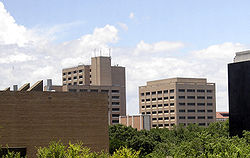
University of Texas at Austin College of Engineering
Encyclopedia

University of Texas at Austin
The University of Texas at Austin is a state research university located in Austin, Texas, USA, and is the flagship institution of the The University of Texas System. Founded in 1883, its campus is located approximately from the Texas State Capitol in Austin...
has more than 7,800 students enrolled in nine undergraduate degrees and thirteen graduate programs. The college is ranked sixth in the world according to the Academic Ranking of World Universities
Academic Ranking of World Universities
The Academic Ranking of World Universities , commonly known as the Shanghai ranking, is a publication that was founded and compiled by the Shanghai Jiaotong University to rank universities globally. The rankings have been conducted since 2003 and updated annually...
and eighth nationally by U.S. News & World Report
U.S. News & World Report
U.S. News & World Report is an American news magazine published from Washington, D.C. Along with Time and Newsweek it was for many years a leading news weekly, focusing more than its counterparts on political, economic, health and education stories...
, while all graduate programs are ranked in the top twenty nationally. With annual research expenditures of over $150 million and the fourth largest number of faculty in the National Academy of Engineering, the Cockrell School of Engineering is highly respected worldwide.
Previously known as the College of Engineering, on July 11, 2007, The University of Texas at Austin renamed the College after 1936 graduate Ernest Cockrell Jr., whose family has over the past 30 years helped to build a $140 million endowment for the College.
Undergraduate departments
College of Engineering undergraduate departments. Rankings, in parentheses, taken from the 2010 edition of U.S. News & World ReportU.S. News & World Report
U.S. News & World Report is an American news magazine published from Washington, D.C. Along with Time and Newsweek it was for many years a leading news weekly, focusing more than its counterparts on political, economic, health and education stories...
unless otherwise specified.
Overall
- Aerospace (8th)*
- Architectural (1st)*
- Biomedical (19th)
- Chemical (5th)*
- Civil (4th)*
- Computer (7th)*
- Electrical/Electronic (10th)
- Environmental (4th)*
- Materials (18th)
- Mechanical (9th)*
- Petroleum/Geosystems (1st)
*from 2011 edition of US News and World Report
Graduate departments
Overall: 8th- Petroleum Engineering (1st)
- Civil Engineering (3rd)
- Environmental Engineering (4th)
- Architectural Engineering (2nd)
- Chemical Engineering (7th)
- Aerospace/Aeronautical Engineering (10th)
- Computer Engineering (9th)
- Electrical/Electronic Engineering (9th)
- Mechanical Engineering (11th)
- Biomedical Engineering (17th)
The Ramshorn
The Ramshorn is one of the most prominent symbols associated with the College of Engineering. Its origins as such can be traced back to over a century ago, when T.U. Taylor, the first engineering faculty member and first dean of the College, began drawing the elaborate checkmark on students' work. A mark reserved for perfect papers, Taylor overheard a student remark he had received a "ramshorn" in 1905, from which the symbol took on its current interpretation and significance. For current engineering students, it is a reminder of the high quality standards associated with all UT Austin engineers, past and present.Alexander Frederick Claire
Alec is one of the most well-known traditions known of the College of Engineering. Over nearly 100 years, Alec has had his share of adventures; however, his beginnings as the patron saint of the College came as the byproduct of the efforts of a group of clever, mischievous sophomore engineers back in 1908.Joe H. Gill and his engineering friends thoughtfully considered how to make a holiday of April Fool's Day. After an unsuccessful attempt involving tying cans around dogs' tails and releasing them to disrupt class, the group of students saw a wooden statue about five feet high while getting refreshments, which they requested to borrow. The next day, Gill presented the statue as their patron saint and traced his ancestry back to ancient times between classes. The presentation successfully broke up classes, and led to his christening as Alexander Frederick Claire, patron saint of UT engineers, exactly one year later. Alec was at the center of a friendly rivalry between law and engineering students for many years, and was subject to numerous escapades such as kidnappings and amputations. Today, what is left of the original wooden statue is safely preserved in the engineering library.
Every year, engineering groups on campus build new Alecs which are then voted on by the students. The winner is announced on April 1 during Alec's birthday party.
Notable faculty
- John B. GoodenoughJohn B. GoodenoughJohn Bannister Goodenough is an American professor and prominent solid-state physicist. He is currently a professor of mechanical engineering and materials science at the University of Texas at Austin...
, responsible for research leading to creation of lithium-ion battery - Hans MarkHans MarkHans Michael Mark is a former Secretary of the Air Force and a former Deputy Administrator of NASA. He is an expert and consultant in aerospace design and national defense policy...
, former Secretary of the Air Force and Deputy Administrator of NASANASAThe National Aeronautics and Space Administration is the agency of the United States government that is responsible for the nation's civilian space program and for aeronautics and aerospace research... - Yale PattYale PattYale Nance Patt is an American professor of electrical and computer engineering at The University of Texas at Austin. He holds the Ernest Cockrell, Jr. Centennial Chair in Engineering. In 1965, Patt introduced the WOS module, the first complex logic gate implemented on a single piece of silicon...
, inventor of the WOS module, the first complex logic gateLogic gateA logic gate is an idealized or physical device implementing a Boolean function, that is, it performs a logical operation on one or more logic inputs and produces a single logic output. Depending on the context, the term may refer to an ideal logic gate, one that has for instance zero rise time and...
implemented on a single piece of silicon - Ilya PrigogineIlya PrigogineIlya, Viscount Prigogine was a Russian-born naturalized Belgian physical chemist and Nobel Laureate noted for his work on dissipative structures, complex systems, and irreversibility.-Biography :...
, recipient of 1977 Nobel Prize in ChemistryNobel Prize in ChemistryThe Nobel Prize in Chemistry is awarded annually by the Royal Swedish Academy of Sciences to scientists in the various fields of chemistry. It is one of the five Nobel Prizes established by the will of Alfred Nobel in 1895, awarded for outstanding contributions in chemistry, physics, literature,...
for his contributions to non-equilibrium thermodynamicsNon-equilibrium thermodynamicsNon-equilibrium thermodynamics is a branch of thermodynamics that deals with systems that are not in thermodynamic equilibrium. Most systems found in nature are not in thermodynamic equilibrium; for they are changing or can be triggered to change over time, and are continuously and discontinuously... - Mary WheelerMary WheelerMary Fanett Wheeler is an American mathematician, noted for her work on numerical methods for partial differential equations, including domain decomposition methods...
, for contributions on numerical solutions to partial differential equations - Larry LakeLarry Lake (engineer)Larry W. Lake is currently W. A. "Monty" Moncrief Centennial Chair in petroleum engineering at the University of Texas at Austin. He has served on the faculty of the Petroleum and Geosystems Department since 1978. He obtained a B.S.E. from Arizona State University and a Ph.D. from Rice University,...
, for contributions on enhanced oil recoveryEnhanced oil recoveryEnhanced Oil Recovery is a generic term for techniques for increasing the amount of crude oil that can be extracted from an oil field...
, reservoir engineering, reservoir characterization and simulation - Kamy SepehrnooriKamy SepehrnooriKamy Sepehrnoori is currently Bank of America Centennial Professor in petroleum engineering at the University of Texas at Austin. He received B.S., M.S. and Ph.D. degrees from the same institution. He is a world famous expert on computational methods, reservoir simulation and numerical solutions to...
for simulation of enhanced oil recovery; computational methods; vector and parallel computations; applied mathematics; subsurface remediation modeling; data bases - Carlos Torres-VerdinCarlos Torres-VerdinCarlos Torres-Verdin is currently Zarrow Centennial Professor in Petroleum Engineering at the University of Texas at Austin. He obtained his B.Sc. degree in geophysical engineering from the National Polytechnic Institute of México, his M.Sc. in electrical engineering from the University of Texas at...
for contributions to geophysics, petrophysics and formation evaluation - Mukul SharmaMukul SharmaMukul M. Sharma is currently Full Professor and W. A. "Tex" Moncrief, Jr. Centennial Chair in Petroleum Engineering at the University of Texas at Austin. He received B.Sc. from the Indian Institute of Technology , M.Sc. and Ph.D. degrees from University of Southern California. He has been...
for contributions to formation damage, petrophysics and fluid flow in porous media. - Gary PopeGary PopeGary A. Pope currently holds the Texaco Centennial Chair in Petroleum Engineering at the University of Texas at Austin. He holds a B.Sc. from Oklahoma State University and a Ph.D. from Rice University, both in chemical engineering. He has previously worked at Shell for more than 7 years and has...
for contributions to reservoir engineering, reservoir simulation and enhanced oil recovery - Russell Johns for contributions to thermodynamics, phase behaviour and fluid properties
- Steven Bryant for contributions to groundwater modeling, and petrophysics
- Quoc Nguyen for contributions to nanoparticles, smart wells and chemical enhanced oil recovery
Student Organizations
The Cockrell School of Engineering is home to over 60 student organizations that offer a wide variety of student groups that provide professional development, service, and social opportunities.- The Student Engineering Council (SEC) is the umbrella organization of all the engineering student organizations, with over thirty engineering organizations affiliated. The SEC is responsible for appropriating thousands of dollars to engineering student organization initiatives, and running the Fall Engineering EXPO, which is the 2nd largest student-run career fair in the United States.
- The American Institute of Chemical Engineers (AICHE) is the primary professional student organization within the Chemical Engineering Department at the University.
- The American Society of Civil Engineers (ASCE) is the primary professional student organization within the Civil Engineering Department at the University.
- The American Society of Mechanical Engineers (ASME) is the primary professional student organization within the Mechanical Engineering Department at the University.
- The Institute of Electrical and Electronics Engineers (IEEE) is the primary professional student organization within the Electrical Engineering Department at the University.
- The Society of Petroleum Engineers (SPE) is the primary professional student organization within the Petroleum Engineering Department at the University.
- The Society of Hispanic Professional Engineers (SHPE) and the National Society of Black Engineers (NSBE) are two professional student organizations who represent minority student engineers at the University.
- The Society of Women Engineers (SWE) is a professional student organization who represents women engineers at the University.

